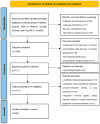Advances in Neuroimaging and Deep Learning for Emotion Detection: A Systematic Review of Cognitive Neuroscience and Algorithmic Innovations
- PMID: 40002607
- PMCID: PMC11854508
- DOI: 10.3390/diagnostics15040456
Advances in Neuroimaging and Deep Learning for Emotion Detection: A Systematic Review of Cognitive Neuroscience and Algorithmic Innovations
Abstract
Background/Objectives: The following systematic review integrates neuroimaging techniques with deep learning approaches concerning emotion detection. It, therefore, aims to merge cognitive neuroscience insights with advanced algorithmic methods in pursuit of an enhanced understanding and applications of emotion recognition. Methods: The study was conducted following PRISMA guidelines, involving a rigorous selection process that resulted in the inclusion of 64 empirical studies that explore neuroimaging modalities such as fMRI, EEG, and MEG, discussing their capabilities and limitations in emotion recognition. It further evaluates deep learning architectures, including neural networks, CNNs, and GANs, in terms of their roles in classifying emotions from various domains: human-computer interaction, mental health, marketing, and more. Ethical and practical challenges in implementing these systems are also analyzed. Results: The review identifies fMRI as a powerful but resource-intensive modality, while EEG and MEG are more accessible with high temporal resolution but limited by spatial accuracy. Deep learning models, especially CNNs and GANs, have performed well in classifying emotions, though they do not always require large and diverse datasets. Combining neuroimaging data with behavioral and cognitive features improves classification performance. However, ethical challenges, such as data privacy and bias, remain significant concerns. Conclusions: The study has emphasized the efficiencies of neuroimaging and deep learning in emotion detection, while various ethical and technical challenges were also highlighted. Future research should integrate behavioral and cognitive neuroscience advances, establish ethical guidelines, and explore innovative methods to enhance system reliability and applicability.
Keywords: brain-computer interaction; cognitive neuroscience; deep learning; emotion detection; emotion recognition; neural networks; neuroimaging.
Conflict of interest statement
The authors declare no conflicts of interest.
Figures












Similar articles
-
From Neural Networks to Emotional Networks: A Systematic Review of EEG-Based Emotion Recognition in Cognitive Neuroscience and Real-World Applications.Brain Sci. 2025 Feb 20;15(3):220. doi: 10.3390/brainsci15030220. Brain Sci. 2025. PMID: 40149742 Free PMC article. Review.
-
Challenging Cognitive Load Theory: The Role of Educational Neuroscience and Artificial Intelligence in Redefining Learning Efficacy.Brain Sci. 2025 Feb 15;15(2):203. doi: 10.3390/brainsci15020203. Brain Sci. 2025. PMID: 40002535 Free PMC article. Review.
-
Enhancing EEG-Based Emotion Detection with Hybrid Models: Insights from DEAP Dataset Applications.Sensors (Basel). 2025 Mar 14;25(6):1827. doi: 10.3390/s25061827. Sensors (Basel). 2025. PMID: 40292995 Free PMC article.
-
Deep learning for electroencephalogram (EEG) classification tasks: a review.J Neural Eng. 2019 Jun;16(3):031001. doi: 10.1088/1741-2552/ab0ab5. Epub 2019 Feb 26. J Neural Eng. 2019. PMID: 30808014 Review.
-
Introducing a novel dataset for facial emotion recognition and demonstrating significant enhancements in deep learning performance through pre-processing techniques.Heliyon. 2024 Oct 4;10(20):e38913. doi: 10.1016/j.heliyon.2024.e38913. eCollection 2024 Oct 30. Heliyon. 2024. PMID: 39640693 Free PMC article.
Cited by
-
Brain-Inspired Multisensory Learning: A Systematic Review of Neuroplasticity and Cognitive Outcomes in Adult Multicultural and Second Language Acquisition.Biomimetics (Basel). 2025 Jun 12;10(6):397. doi: 10.3390/biomimetics10060397. Biomimetics (Basel). 2025. PMID: 40558367 Free PMC article. Review.
-
The Journey of the Default Mode Network: Development, Function, and Impact on Mental Health.Biology (Basel). 2025 Apr 10;14(4):395. doi: 10.3390/biology14040395. Biology (Basel). 2025. PMID: 40282260 Free PMC article. Review.
-
Neurotechnological Approaches to Cognitive Rehabilitation in Mild Cognitive Impairment: A Systematic Review of Neuromodulation, EEG, Virtual Reality, and Emerging AI Applications.Brain Sci. 2025 May 28;15(6):582. doi: 10.3390/brainsci15060582. Brain Sci. 2025. PMID: 40563754 Free PMC article. Review.
-
Mindfulness-Based Cognitive Therapy in Clinical Practice: A Systematic Review of Neurocognitive Outcomes and Applications for Mental Health and Well-Being.J Clin Med. 2025 Mar 3;14(5):1703. doi: 10.3390/jcm14051703. J Clin Med. 2025. PMID: 40095733 Free PMC article. Review.
-
Neuroimaging Insights into the Public Health Burden of Neuropsychiatric Disorders: A Systematic Review of Electroencephalography-Based Cognitive Biomarkers.Medicina (Kaunas). 2025 May 28;61(6):1003. doi: 10.3390/medicina61061003. Medicina (Kaunas). 2025. PMID: 40572691 Free PMC article.
References
-
- Lindquist K.A., Jackson J.C., Leshin J., Satpute A.B., Gendron M. The cultural evolution of emotion. Nat. Rev. Psychol. 2022;1:669–681. doi: 10.1038/s44159-022-00105-4. - DOI
-
- Eslinger P.J., Anders S., Ballarini T., Boutros S., Krach S., Mayer A.V., Moll J., Newton T.L., Schroeter M.L., de Oliveira-Souza R., et al. The neuroscience of social feelings: Mechanisms of adaptive social functioning. Neurosci. Biobehav. Rev. 2021;128:592–620. doi: 10.1016/j.neubiorev.2021.05.028. - DOI - PMC - PubMed
Publication types
LinkOut - more resources
Full Text Sources

